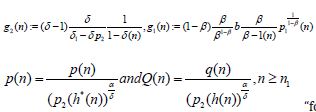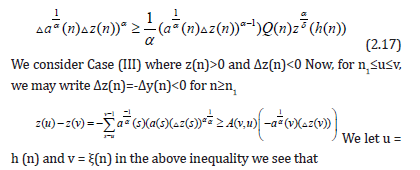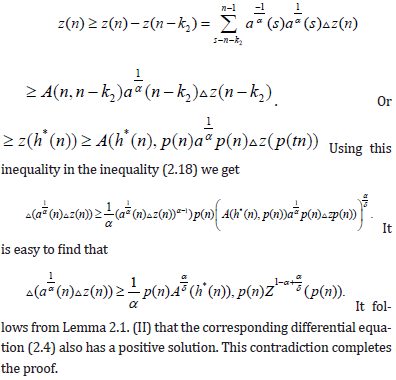Impact Factor : 0.548
- NLM ID: 101723284
- OCoLC: 999826537
- LCCN: 2017202541
Said R Grace*
Received: November 28, 2022; Published: December 09, 2022
*Corresponding author: Said R Grace, Department of Engineering Mathematics, Faculty of Engineering, Cairo University, Orman, Giza 12221, Egypt
DOI: 10.26717/BJSTR.2022.47.007522
This paper deals with the oscillation of second order nonlinear difference equations with mixed nonlinear neutral terms. The purpose of the present paper is the linearization of the considered equation in the sense that we would deduce oscillation of studied equation from that of the linear form and to provide new oscillation criteria via comparison with first order equations whose oscillatory behavior are known. The obtained results are new, improve and correlate many of the known oscillation criteria appeared in the literature. The results are illustrated by some examples.
Keywords: Second Order; Nonlinear; Neutral; Mixed Type; Oscillation AMS (MOS) Classification 34N05, 39A10
This paper is concerned with oscillatory behavior of all solutions of the nonlinear second order difference equations with mixed neutral terms of the form

where

We shall assume that
α,β,γ,μ” and “ δ are the ratios of positive odd integers,α≥1
{p_1 (n)},{p_2 (n)}, {q (n)} and {p (n)} are sequences of positive real numbers.
k, m, m*are positive real numbers with h (n) = n– m + k + 1 and h* (n) = n + m* + k.
We let

for

In this section we study some oscillation criteria for equation (1.1) when β<1” and “ δ>1. We start with the following fundamental result. See [10, Lemma 1], and for the proof of (I), see [15, Lemma 2.2].
Lemma 2.1. Let {q (n)} be a sequence of positive real numbers, m and m*are positive real number and f: R→ R is a continuous nondecreasing function, and x f(x) > 0 for x≠0,
The first order delay differential inequality
y(n) + q(n) f ( y(n −m+1)) ≤ 0 has an eventually positive solution, so does the delay equation
y(n) + q(t) f ( y(t −m+)) ≤ 0
The first order advanced differential inequality
y(t) − q(n) f ( y(n + m*)) ≥ 0 has an eventually positive solution, so does the delay equation y(n) − q(n) f ( y(n + m*)) = 0 Lemma 2.2. [13]. If X and Y are nonnegative, then
Xλ + (λ −1)Yλ −λ XYλ −1 ≥ 0 forλ >1, (2.1)
Xλ − (1−λ )Yλ −λ XYλ −1 ≤ 0 for0 < λ <1 (2.2)
where equality is held if and only if X = Y.
In what follows, we let

"for some n"≥n_0," where " {b (n)} is a sequence of positive real numbers
Now, we present the following oscillation result. Theorem 2.1. Let β<1” and “ δ>1, conditions (i) – (iv) and (1.3) hold. Assume that there exist positive sequences (b (t)} and positive real numbers k1and k2 such that k1 < m-k1 and k2 < m* + k +1 such that

If the first order advanced equation

is oscillatory, where ρ(n) = n +m*+k-k2>t, and assume that there exists a number θ∈(0,1) such that both the delay equations

for some n1≥n0 and

where, ξ(n)=n-m+k1+1<t
Proof. Let {w (n)} be a nonoscillatory solution of equation (1.1), say w (n) > 0, w(n-k)>0 ,w(n-m+1)>0 , and w(n+ m*+1)>0 for n≥n1 for some n1≥n. It follows from equation (1.1) that

Hence





From equation (1.1) one can easily see that

From (2.9) one can easily get

We shall distinguish the following four cases:


First, we consider Case (I): Since



Or

If we apply (2.1) with

we have

Thus, we see that

Since y (t) in nondecreasing, there exists a constant C > 0 such that y(n)≥C , and so, we have

Now, there exists a constant c1∈(0,1) such that

Using (2.11) in (2.10), we have

Clearly, we see that

Using this inequality in (2.12), we find







It follows from Lemma 2.1. (I) that the corresponding differential equation (2.5) also has a positive solution, a contradiction. Next, we consider the cases when y (n) < 0 fort≥t2.
Let

Or

From (2.16) one can easily find that


Using (2.19) in (2.17), we have

which finally takes the form

where W (n) =


We note that the results of this paper can be extended easily to the more general equations of the for

where the coefficients are the same as in equation (1,1) with γ and μ are the ratio of positive odd integers. The details are left to the reader. For the special case when α= δ, i.e. ,the equation &


(2.21) we have the following interesting results Corollary 2.1. Let the hypotheses of Theorem 2.1 hold with equations (2.4) and (2.6) are replaced (respectively) by:

(2.23) Then equation (2.20) is oscillatory.
We also have the following result from corollary 2.1 for equation (2.21): Corollary 2.2. Let the hypotheses of Theorem 2.1 hold with equations (2.4) and (2.6) are replaced (respectively) by

Then equation (2.21) is oscillatory.
The following corollary is to employ some integral conditions rather than the oscillatory behavior of first order equations involved. Corollary 2.3. Let the hypotheses of Theorem 2.1 hold. If

And

then equation (2.20) is oscillatory. The following example is illustrative: Example 2.1. Consider the mixed neutral second order differential equations

Here we have


The paper is presented in a form which is essentially and of high degree of generality. It will be of interest to study these results for the higher order of the

The author declare that they have no competing interests.
Not Applicable.


